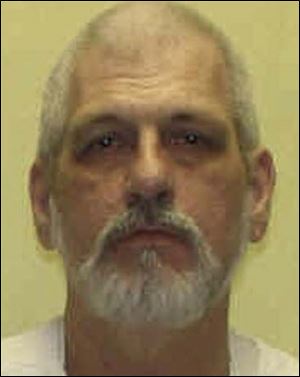
Cleveland-area killer put to death
Likely last in state to be executed using drug pentobarbital
9/25/2013
Harry Mitts, Jr.
LUCASVILLE, Ohio -- As police tried to talk him into surrendering 19 years ago, Harry Mitts, Jr. reportedly told them, “The only way we’re going to end this is if you kill me.”
Today, the state of Ohio did put Mitts, 61, to death for killing a police officer and a neighbor's boyfriend during an hours-long shooting rampage in 1994 in and outside his Cleveland-area apartment building.
He was pronounced dead at 10:39 a.m. from a massive dose of a single drug, pentobarbital, at the Southern Ohio Correctional Facility at Lucasville.
Before the drug began flowing, he turned his head and looked directly at the family members of his victims who witnessed his execution.
"To John Bryant and Dennis Glivar's families, I'm so sorry for taking your loved ones' lives," he told them while lying on the gurney. "I had no business doing what I did, and I've been carrying that burden for 19 years. Please don't carry that hatred for me with you in your hearts."
As Mr. Bryant's sister, Johnnal, sobbed, Mitts urged them instead to welcome Jesus Christ into their lives.
"I'm sorry for having taken your loved ones' lives," he said again, " and please forgive me."
He was likely the last to be put to death in Ohio with that drug. A national shortage of the pentobarbital will force the state to again change its lethal injection protocol before the next scheduled execution on Nov. 14. The drug’s European manufacturers object to its use in executions.
During a recent interview with the Ohio Parole Board, Mitts said he was trying to commit suicide by police, shooting someone with whom he had no quarrel to draw Garfield Heights police to his building to shoot him. After being shot himself, he said he changed his mind and returned fire in a fight for survival.
At trial, his lawyer unsuccessfully argued that Mitts went on the shooting rampage during an alcohol-fueled blackout, but Mitts himself later refuted that defense.
Mitts, who was white, apparently targeted John A. Bryant, 28, a neighbor’s boyfriend, because he was black. Witnesses recounted that he spewed racial epithets as he shot Mr. Bryant while not harming his girlfriend, who was white, or the white neighbors who came to Mr. Bryant’s aid.
However, Mitts later said he was not a racist and did not personally remember making the comments. After his conviction, he maintained that he lashed out after losing his wife to a police officer. He told the parole board that he’d been stalking both his ex-wife and her new husband, but didn’t kill them out of his concern for his own daughter living with them.
During the standoff that followed, Mitts killed Sgt. Dennis Glivar, 44, wounded two other officers who survived, and then picked up the slain officer’s shotgun and began firing randomly into the walls of apartments.
Mr. Glivar’s mother, Helen, and a sister had previously given Mitts a Bible as they expressed their forgiveness for what he had done. Ms. Glivar and the officer's widow, Debbie, were among the witnesses in addition to Mr. Bryant’s sister.
Also witnessing was Capt. Tom Kaiser, who on that 1994 night was a police lieutenant, Mr. Glivar’s squad car partner, and friend. Mr. Kaiser was shot twice by Mitts.
“Ten minutes before the call came in on East 88th Street, we were eating lunch behind Garfield Mall and complaining about the Major League Baseball players who had just gone out on strike,” he told the parole board in August. “Ten minutes later, we were standing side by side when we were cowardly ambushed by Harry Mitts outside his apartment door. Dozens of lives were shattered from that moment on.”
Gov. John Kasich rejected Mitts’ request for clemency after the parole board unanimously recommended against it.
“…(I)f Mitts’s purpose was simply to be shot and killed by the police, he could have accomplished that by pointing an unloaded gun at officers,” wrote the board. “It also speaks volumes that Mitts did not immediately surrender after he supposedly decided that he wanted to live.”
In his interview with the parole board, Mitts did not specifically request clemency and expressed some indifference as to whether he would spend the rest of his natural life in prison or go, as he said he believed, to Jesus Christ now.
The execution medical team appeared to have no problem inserting the shunts for the drug. Mitts appeared to answer questions during the process. Once the drug began to flow, he seemed to fall asleep, began to deep breathe more deeply, and began snoring. After he appeared to stop breathing, his mouth continued to move before he became still.